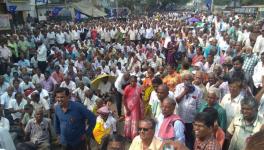‘Code on Social Security’ Omits Anganwadi, ASHAs as ‘Employees’, Unlike in Earlier Drafts

File Photo.
New Delhi: The definition of ‘employee’ in Clause 2(26) of the Code on Social Security 2019, which subsumes nine labour Acts, has left out many types of workers from its ambit, such as Anganwadi and ASHA workers, who were included in the earlier drafts.
This has been pointed out in a recent report by the parliamentary Standing Committee on Labour, headed by Biju Janata Dal MP, Bhartruhari Mahtab, which met on July 29. The report was uploaded on the Lok Sabha website on July 31.
The Narendra Modi government’s proposal to subsume nine labour related Acts into ‘The Code on Social Security, 2019’ was introduced in Lok Sabha on December 11, 2019 and referred to the Standing Committee on Labour on December 24.
Among various objectives, the Code envisions “to empower the Central Government, by notification, to constitute a Social Security Fund or funds for provision of social security for the unorganised workers, e-platform workers or gig workers or any such class of workers.”
However, in its discussions and representations received by various stakeholders, the parliamentary panel found that the definition 'employee' was exclusionary and called for its expansion to “encompass all sorts of workers, such as Anganwadi and ASHA workers, as found place in earlier drafts of the 27 Code.”
The panel also found that many other workers would be deprived of Employees State Insurance (ESI) and Employees Provident Fund (EPF) benefits because of the proposed low wage ceiling.
“The Committee find that the definition of ‘employee’ in Clause 2(26) has left out many types of workers from its ambit though the earlier drafts included Anganwadi and ASHA workers etc. Further, the first proviso to the clause stipulating that ‘the wage ceiling for employees for the purpose of applicability of Chapters III & IV to be notified by the Government’ appears to be restrictive in nature in terms of coverage,” said the report, adding that the “prescribed low wage ceiling of Rs.15,000/- for EPF and Rs.21,000/- for ESIC, would exclude many informal workers in the formal sector from the ambit of EPF and ESIC benefits.”
On the Labour Ministry’s clarification that provisions for determining wage thresholds by Centre for such workers was “as per the existing practice”, the panel said “just because a practice has been going on since ages, it does not any way obstruct the Government to initiate improvements in the existing system.”
It urged the Labour Ministry to make more efforts to determine wage thresholds through an automatic process of wages indexation with Consumer Price Index periodically.
Gig Workers
The committee also noted some confusion regarding gig and e-platform workers (e-economy workers, such as delivery persons), and asked the Ministry to bring in more clarity.
It noted that while Clause 45 of the Code “contemplates bringing the Gig Workers and Platform Workers under the ESI Scheme, which is basically meant for the Organised Sector, they are also included under the Chapter on ‘Social Security for the Unorganised Workers’ wherein Clause 114 provides for framing of exclusive Schemes for Gig Workers and Platform Workers.”
Since specific welfare schemes are envisaged in the Code for ‘Unorganised Workers’ and the ‘Organised Sector’, the Committee said the definitions indicate an ambiguity on “whether a particular worker belongs to the Unorganised Sector or Organised Sector or both”, adding that adequate safeguards are needed to ensure that “multiplicity in definitions” do not become a hurdle in extending social security benefits to any worker.
Among various other issues taken up by the committee, it also noted the used of open-ended terms that created a lot of apprehension.
“The codification exercise is full of stipulations like "as may be specified"; "as may be prescribed"; "as may be framed"; etc. in respect of almost all substantive provisions pertaining to entitlement, contributions, benefits, etc” noted the report.
While the Labour Ministry said this was “a conscious decision” of the government as it “provides for dynamism and flexibility to those provisions which are amenable to change as per the needs of time, without undermining the powers of Parliament”, the committee questioned whether so many “substantive provisions ought to be left to the Executive Orders when an important legislation is being framed by subsuming with it as many as nine extant Labour Laws”
The parliamentary panel said welfare of workers was a “noble intent”, and hence “should universally be extended to workers from all social strata.”
For a truly ‘dynamic’ law, therefore, the Labour Ministry needs have a relook at those Labour Welfare Laws that have been left out of the amalgamation process, irrespective of the abolition, to ensure that the Code does not discriminate against any member of the country’s labour force, the committee said.
Get the latest reports & analysis with people's perspective on Protests, movements & deep analytical videos, discussions of the current affairs in your Telegram app. Subscribe to NewsClick's Telegram channel & get Real-Time updates on stories, as they get published on our website.
























